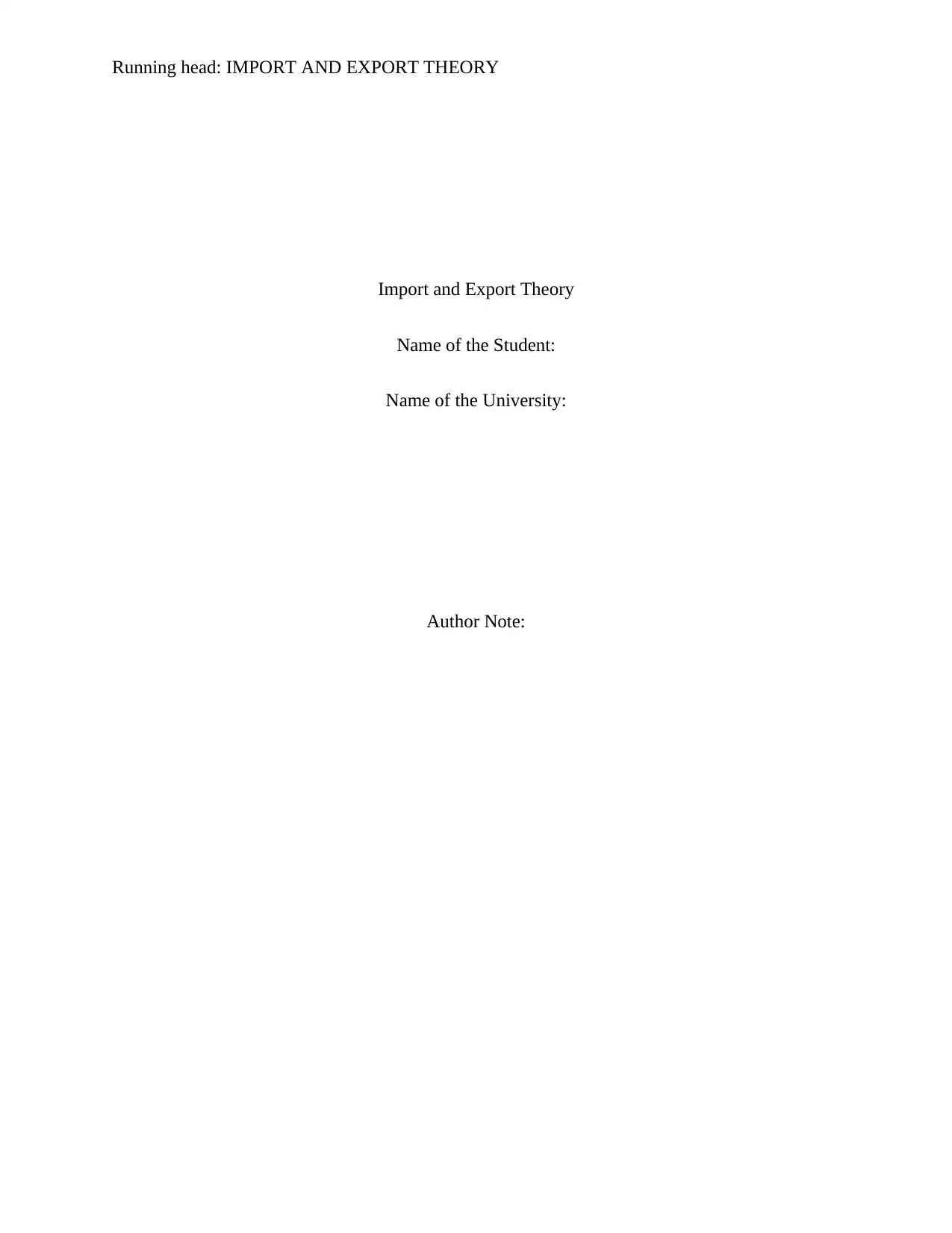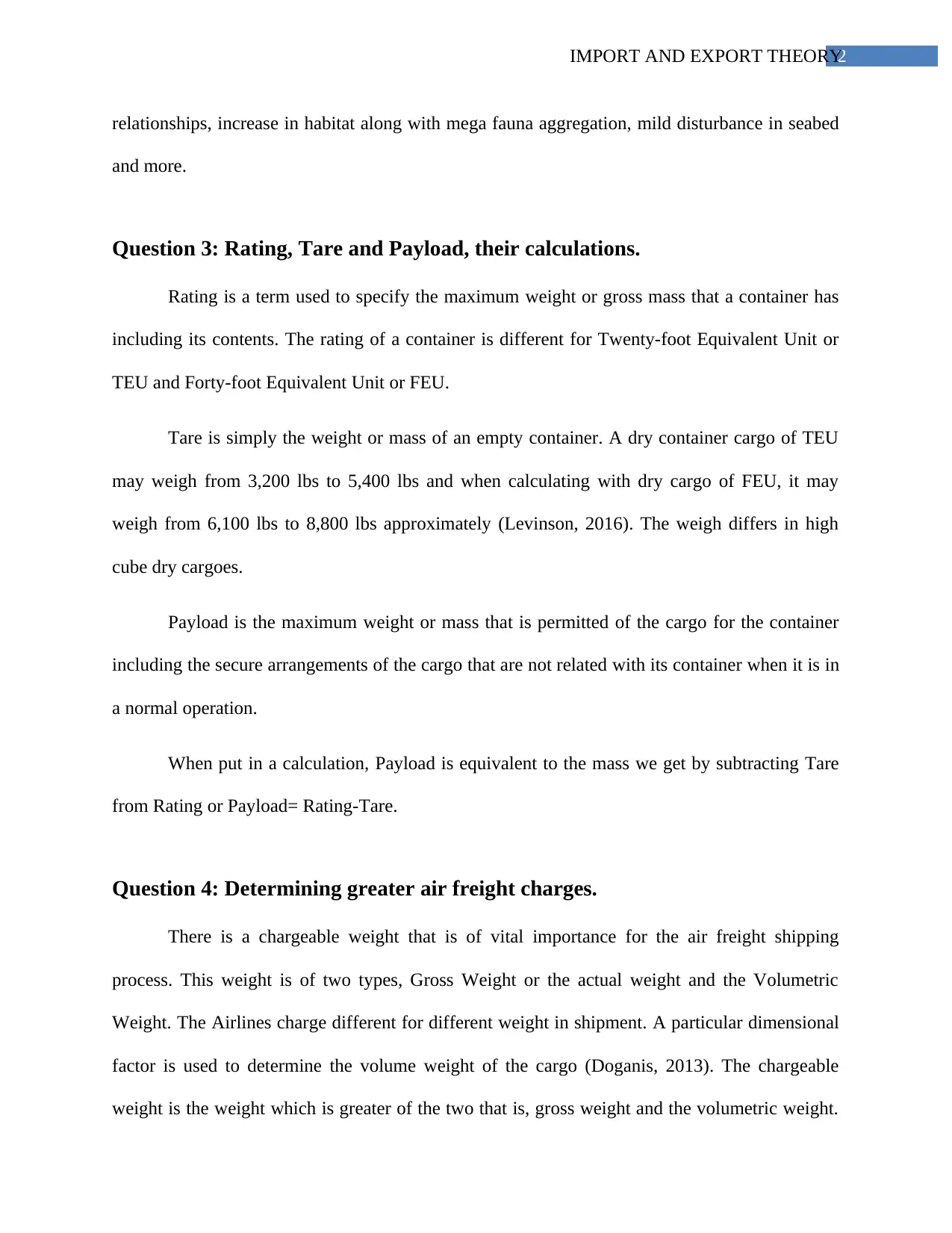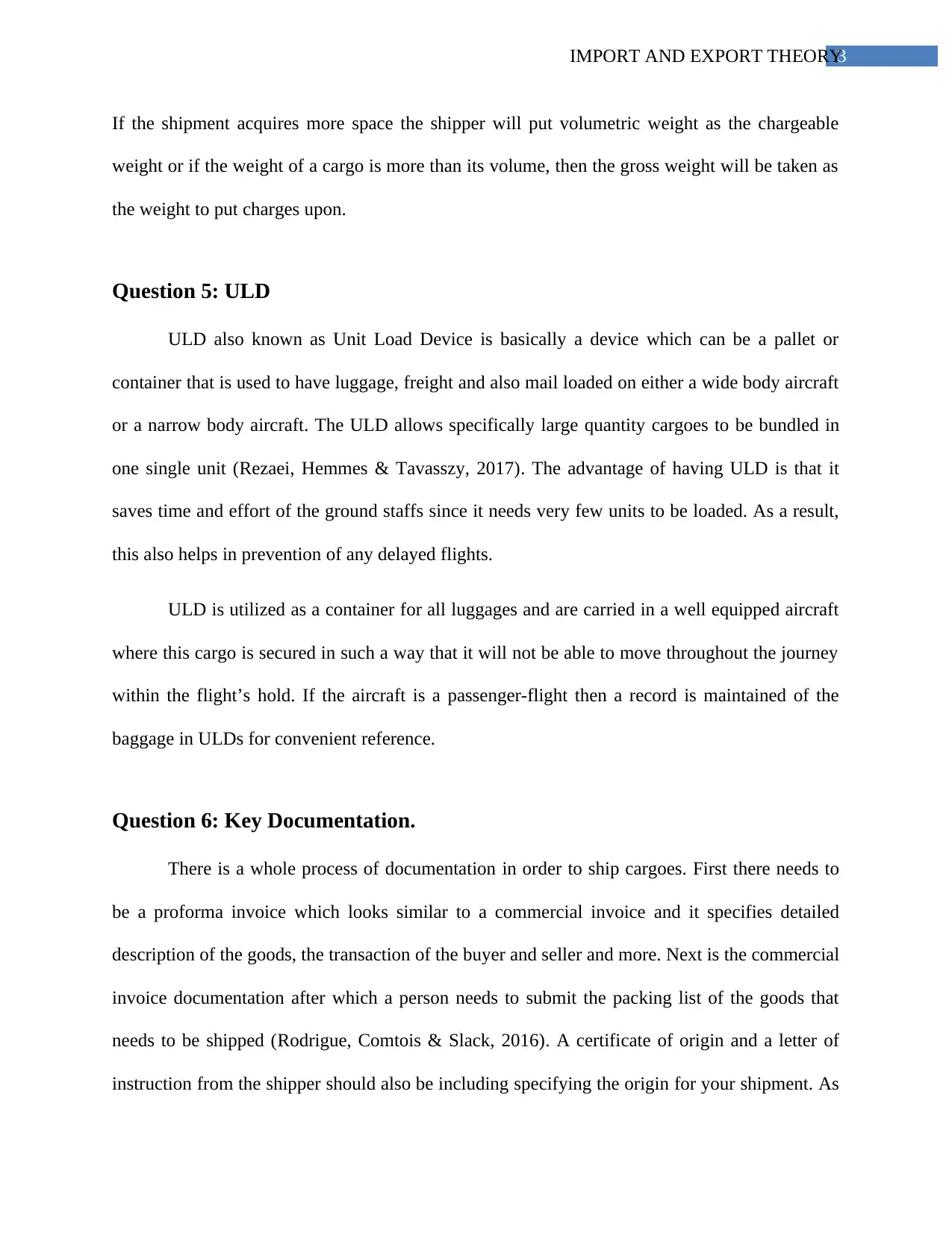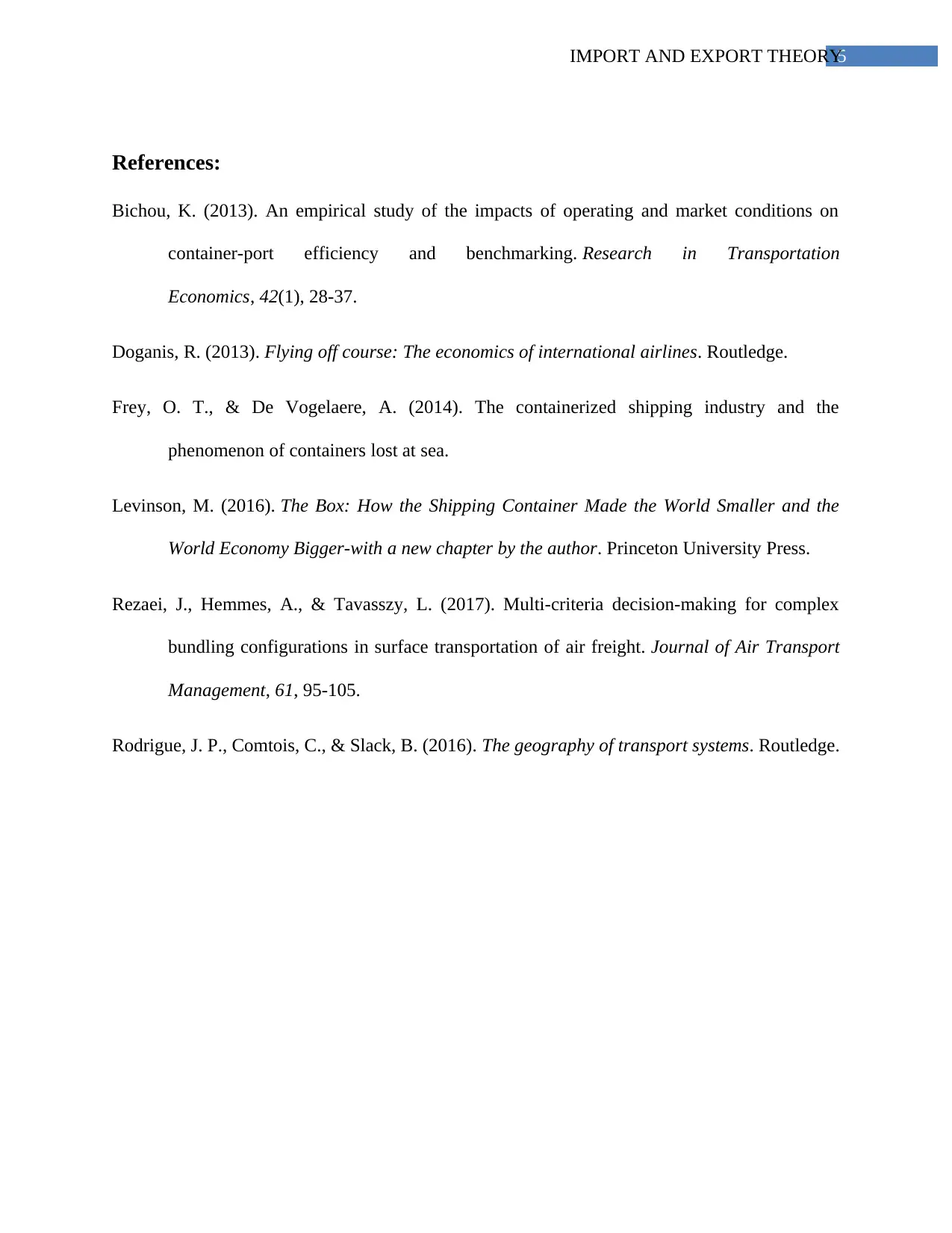Import and Export Theory: Key Concepts and Analysis
VerifiedAdded on 2022/10/06
|6
|1230
|19
Homework Assignment
AI Summary
This assignment solution delves into key aspects of import and export theory. It begins by comparing and contrasting Full Container Load (FCL) and Less than Container Load (LCL) lead times, explaining why LCL shipments often experience delays. The solution then explores the sea shipping revolution of the 1970s, focusing on the impact of containerization on global trade, including its environmental consequences. The assignment also covers essential calculations, such as rating, tare, and payload, crucial for understanding container capacity. Furthermore, it addresses the determination of air freight charges, emphasizing the significance of chargeable weight. The solution also explains Unit Load Devices (ULDs) and their role in streamlining air cargo operations. Finally, it outlines the key documentation required for shipping goods, including proforma invoices, commercial invoices, packing lists, bills of lading, and other essential forms. The assignment is well-structured and includes proper citations.

Running head: IMPORT AND EXPORT THEORY
Import and Export Theory
Name of the Student:
Name of the University:
Author Note:
Import and Export Theory
Name of the Student:
Name of the University:
Author Note:
Paraphrase This Document
Need a fresh take? Get an instant paraphrase of this document with our AI Paraphraser

1IMPORT AND EXPORT THEORY
Question 1: Reason why LCL lead times are longer than FCL lead times.
Full Container Load or FCL is used exclusively for a particular shipment contained in a
cargo that is not shared with any other cargo shipments. Whereas Less than Container Load or
LCL is a term in the arena of shipping that is used when various shipments share a same cargo
container (Bichou, 2013). The lead times in FCL are less as compared to the LCL, since the
cargo meant for FCL contains shipment for a single entity, thus even if this cargo goes through
various ports, it does not have to be opened several times and packed again like LCL, which
causes delay. Moreover, the LCL not only causes delay in the journey, it also costs more than
FCL as the cost per freight is higher regardless of the size of the good; LCL also includes
insurance costs.
Question 2: Sea shipping Revolution 1970. Its Impacts and flow-on effects.
Until the 1970s, the shipping of goods through sea was done in lose; the goods were
crammed altogether in some old fashioned cargoes (Frey & De Vogelaere, 2014). In the year
1970, the sea shipping revolution brought the element of “Containerization”, which allowed
goods to be travelled through big boxes or Shipping Containers (Frey & De Vogelaere, 2014).
This revolution became a global phenomenon; since Standardization was introduced in
sea-shipping; the shipment became flexible, the transport costs were lowered and most
importantly, the goods were shipped secured and in safe manner.
However there is one flow on effect that Containerization has on the environment, which
is beyond cargo shipping. It has been studied and found that a container lost in the sea has a
major impact in the aquatic environment surrounding it. There is visible impact in predator-prey
Question 1: Reason why LCL lead times are longer than FCL lead times.
Full Container Load or FCL is used exclusively for a particular shipment contained in a
cargo that is not shared with any other cargo shipments. Whereas Less than Container Load or
LCL is a term in the arena of shipping that is used when various shipments share a same cargo
container (Bichou, 2013). The lead times in FCL are less as compared to the LCL, since the
cargo meant for FCL contains shipment for a single entity, thus even if this cargo goes through
various ports, it does not have to be opened several times and packed again like LCL, which
causes delay. Moreover, the LCL not only causes delay in the journey, it also costs more than
FCL as the cost per freight is higher regardless of the size of the good; LCL also includes
insurance costs.
Question 2: Sea shipping Revolution 1970. Its Impacts and flow-on effects.
Until the 1970s, the shipping of goods through sea was done in lose; the goods were
crammed altogether in some old fashioned cargoes (Frey & De Vogelaere, 2014). In the year
1970, the sea shipping revolution brought the element of “Containerization”, which allowed
goods to be travelled through big boxes or Shipping Containers (Frey & De Vogelaere, 2014).
This revolution became a global phenomenon; since Standardization was introduced in
sea-shipping; the shipment became flexible, the transport costs were lowered and most
importantly, the goods were shipped secured and in safe manner.
However there is one flow on effect that Containerization has on the environment, which
is beyond cargo shipping. It has been studied and found that a container lost in the sea has a
major impact in the aquatic environment surrounding it. There is visible impact in predator-prey

2IMPORT AND EXPORT THEORY
relationships, increase in habitat along with mega fauna aggregation, mild disturbance in seabed
and more.
Question 3: Rating, Tare and Payload, their calculations.
Rating is a term used to specify the maximum weight or gross mass that a container has
including its contents. The rating of a container is different for Twenty-foot Equivalent Unit or
TEU and Forty-foot Equivalent Unit or FEU.
Tare is simply the weight or mass of an empty container. A dry container cargo of TEU
may weigh from 3,200 lbs to 5,400 lbs and when calculating with dry cargo of FEU, it may
weigh from 6,100 lbs to 8,800 lbs approximately (Levinson, 2016). The weigh differs in high
cube dry cargoes.
Payload is the maximum weight or mass that is permitted of the cargo for the container
including the secure arrangements of the cargo that are not related with its container when it is in
a normal operation.
When put in a calculation, Payload is equivalent to the mass we get by subtracting Tare
from Rating or Payload= Rating-Tare.
Question 4: Determining greater air freight charges.
There is a chargeable weight that is of vital importance for the air freight shipping
process. This weight is of two types, Gross Weight or the actual weight and the Volumetric
Weight. The Airlines charge different for different weight in shipment. A particular dimensional
factor is used to determine the volume weight of the cargo (Doganis, 2013). The chargeable
weight is the weight which is greater of the two that is, gross weight and the volumetric weight.
relationships, increase in habitat along with mega fauna aggregation, mild disturbance in seabed
and more.
Question 3: Rating, Tare and Payload, their calculations.
Rating is a term used to specify the maximum weight or gross mass that a container has
including its contents. The rating of a container is different for Twenty-foot Equivalent Unit or
TEU and Forty-foot Equivalent Unit or FEU.
Tare is simply the weight or mass of an empty container. A dry container cargo of TEU
may weigh from 3,200 lbs to 5,400 lbs and when calculating with dry cargo of FEU, it may
weigh from 6,100 lbs to 8,800 lbs approximately (Levinson, 2016). The weigh differs in high
cube dry cargoes.
Payload is the maximum weight or mass that is permitted of the cargo for the container
including the secure arrangements of the cargo that are not related with its container when it is in
a normal operation.
When put in a calculation, Payload is equivalent to the mass we get by subtracting Tare
from Rating or Payload= Rating-Tare.
Question 4: Determining greater air freight charges.
There is a chargeable weight that is of vital importance for the air freight shipping
process. This weight is of two types, Gross Weight or the actual weight and the Volumetric
Weight. The Airlines charge different for different weight in shipment. A particular dimensional
factor is used to determine the volume weight of the cargo (Doganis, 2013). The chargeable
weight is the weight which is greater of the two that is, gross weight and the volumetric weight.
⊘ This is a preview!⊘
Do you want full access?
Subscribe today to unlock all pages.

Trusted by 1+ million students worldwide

3IMPORT AND EXPORT THEORY
If the shipment acquires more space the shipper will put volumetric weight as the chargeable
weight or if the weight of a cargo is more than its volume, then the gross weight will be taken as
the weight to put charges upon.
Question 5: ULD
ULD also known as Unit Load Device is basically a device which can be a pallet or
container that is used to have luggage, freight and also mail loaded on either a wide body aircraft
or a narrow body aircraft. The ULD allows specifically large quantity cargoes to be bundled in
one single unit (Rezaei, Hemmes & Tavasszy, 2017). The advantage of having ULD is that it
saves time and effort of the ground staffs since it needs very few units to be loaded. As a result,
this also helps in prevention of any delayed flights.
ULD is utilized as a container for all luggages and are carried in a well equipped aircraft
where this cargo is secured in such a way that it will not be able to move throughout the journey
within the flight’s hold. If the aircraft is a passenger-flight then a record is maintained of the
baggage in ULDs for convenient reference.
Question 6: Key Documentation.
There is a whole process of documentation in order to ship cargoes. First there needs to
be a proforma invoice which looks similar to a commercial invoice and it specifies detailed
description of the goods, the transaction of the buyer and seller and more. Next is the commercial
invoice documentation after which a person needs to submit the packing list of the goods that
needs to be shipped (Rodrigue, Comtois & Slack, 2016). A certificate of origin and a letter of
instruction from the shipper should also be including specifying the origin for your shipment. As
If the shipment acquires more space the shipper will put volumetric weight as the chargeable
weight or if the weight of a cargo is more than its volume, then the gross weight will be taken as
the weight to put charges upon.
Question 5: ULD
ULD also known as Unit Load Device is basically a device which can be a pallet or
container that is used to have luggage, freight and also mail loaded on either a wide body aircraft
or a narrow body aircraft. The ULD allows specifically large quantity cargoes to be bundled in
one single unit (Rezaei, Hemmes & Tavasszy, 2017). The advantage of having ULD is that it
saves time and effort of the ground staffs since it needs very few units to be loaded. As a result,
this also helps in prevention of any delayed flights.
ULD is utilized as a container for all luggages and are carried in a well equipped aircraft
where this cargo is secured in such a way that it will not be able to move throughout the journey
within the flight’s hold. If the aircraft is a passenger-flight then a record is maintained of the
baggage in ULDs for convenient reference.
Question 6: Key Documentation.
There is a whole process of documentation in order to ship cargoes. First there needs to
be a proforma invoice which looks similar to a commercial invoice and it specifies detailed
description of the goods, the transaction of the buyer and seller and more. Next is the commercial
invoice documentation after which a person needs to submit the packing list of the goods that
needs to be shipped (Rodrigue, Comtois & Slack, 2016). A certificate of origin and a letter of
instruction from the shipper should also be including specifying the origin for your shipment. As
Paraphrase This Document
Need a fresh take? Get an instant paraphrase of this document with our AI Paraphraser

4IMPORT AND EXPORT THEORY
per the bill of lading that is required, there are three types of such bills; Inland bill of lading,
Ocean bill of Lading and Airway bill. These bills can be straight bill or negotiable as the
circumstances demand. Lastly a bank draft and a dangerous good form should be given to proper
authorities.
per the bill of lading that is required, there are three types of such bills; Inland bill of lading,
Ocean bill of Lading and Airway bill. These bills can be straight bill or negotiable as the
circumstances demand. Lastly a bank draft and a dangerous good form should be given to proper
authorities.

5IMPORT AND EXPORT THEORY
References:
Bichou, K. (2013). An empirical study of the impacts of operating and market conditions on
container-port efficiency and benchmarking. Research in Transportation
Economics, 42(1), 28-37.
Doganis, R. (2013). Flying off course: The economics of international airlines. Routledge.
Frey, O. T., & De Vogelaere, A. (2014). The containerized shipping industry and the
phenomenon of containers lost at sea.
Levinson, M. (2016). The Box: How the Shipping Container Made the World Smaller and the
World Economy Bigger-with a new chapter by the author. Princeton University Press.
Rezaei, J., Hemmes, A., & Tavasszy, L. (2017). Multi-criteria decision-making for complex
bundling configurations in surface transportation of air freight. Journal of Air Transport
Management, 61, 95-105.
Rodrigue, J. P., Comtois, C., & Slack, B. (2016). The geography of transport systems. Routledge.
References:
Bichou, K. (2013). An empirical study of the impacts of operating and market conditions on
container-port efficiency and benchmarking. Research in Transportation
Economics, 42(1), 28-37.
Doganis, R. (2013). Flying off course: The economics of international airlines. Routledge.
Frey, O. T., & De Vogelaere, A. (2014). The containerized shipping industry and the
phenomenon of containers lost at sea.
Levinson, M. (2016). The Box: How the Shipping Container Made the World Smaller and the
World Economy Bigger-with a new chapter by the author. Princeton University Press.
Rezaei, J., Hemmes, A., & Tavasszy, L. (2017). Multi-criteria decision-making for complex
bundling configurations in surface transportation of air freight. Journal of Air Transport
Management, 61, 95-105.
Rodrigue, J. P., Comtois, C., & Slack, B. (2016). The geography of transport systems. Routledge.
⊘ This is a preview!⊘
Do you want full access?
Subscribe today to unlock all pages.

Trusted by 1+ million students worldwide
1 out of 6
Your All-in-One AI-Powered Toolkit for Academic Success.
+13062052269
info@desklib.com
Available 24*7 on WhatsApp / Email
![[object Object]](/_next/static/media/star-bottom.7253800d.svg)
Unlock your academic potential
Copyright © 2020–2025 A2Z Services. All Rights Reserved. Developed and managed by ZUCOL.
